Gigabyte's i-RAM: Affordable Solid State Storage
by Anand Lal Shimpi on July 25, 2005 3:50 PM EST- Posted in
- Storage
Using the i-RAM
To begin our testing, we loaded up the i-RAM with four 1GB DDR400 sticks. We didn't have any large DDR200 modules, so unfortunately we had to go with more modern DDR400. Using DDR500, DDR400 or DDR200 doesn't change performance at all, since the Xilinx controller runs them all at the same frequency.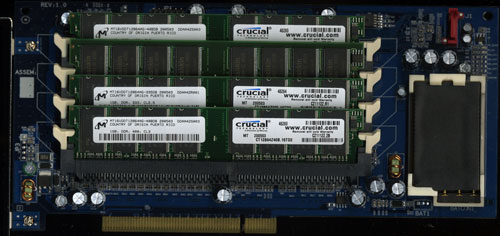
Powering the system on revealed the installation was a success; the BIOS reported the presence of the i-RAM as a regular storage device connected to our SATA controller:
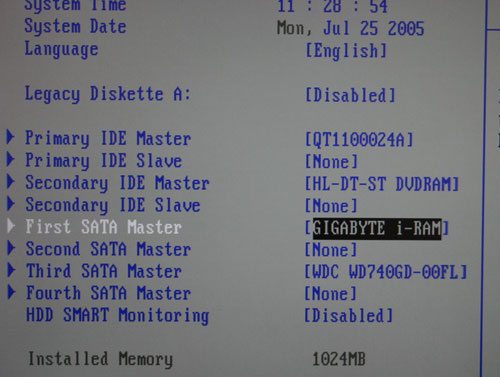
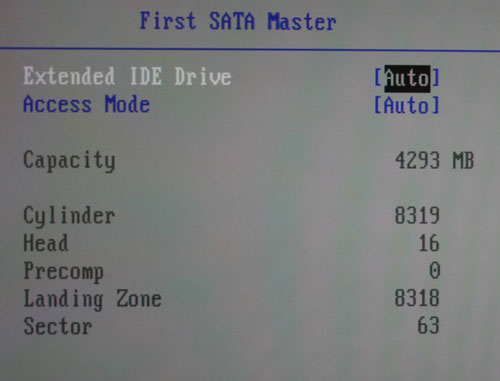
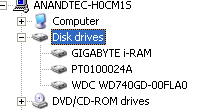
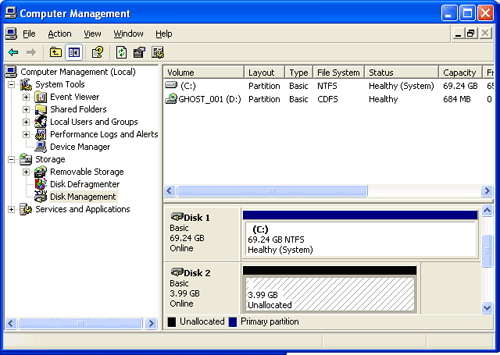
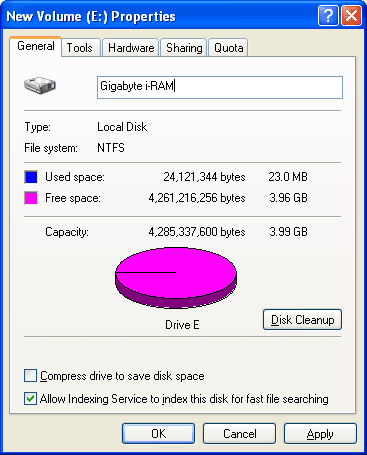
Also, all disk accesses are instantaneous; formatting the thing takes no time at all, and you can even "defragment" it (although, you get no benefit from doing so).
With the setup done, it was time to evaluate the i-RAM as more than just a novelty silent hard drive. Armed with our 4GB partition, we started testing...
The Test
We ran all of our tests on the following testbed unless otherwise noted:ASUS A8N SLI Deluxe nForce4 SLI Motherboard
AMD Athlon 64 FX-57 Processor
1 GB OCZ 2:2:2:7 DDR400 RAM
Seagate 7200.7 120 GB Hard Drive (boot drive)
Western Digital Raptor W740GD (test drive)
Gigabyte i-RAM w/ 4x1GB DDR400 modules (test drive)
We used the latest nForce 6.53 and ForceWare 77.72 drivers for our test bed, and paired it with the recently released GeForce 7800 GTX.










133 Comments
View All Comments
simpletech - Tuesday, July 26, 2005 - link
I think another possible use (besides certain kinds of servers, like mail servers), is for video capture. The size is a bit small, but if you were capturing segments of footage, it might work. And the price could be reasonable.BikeDude - Tuesday, July 26, 2005 - link
"but 32-bit Windows can't use more than 4GB of RAM, including the swap file size."First of all... "Swap file" is a misnomer. We talked about "swap file" back in the Windows 3.1 days when the OS would swap a process' entire memory space to the *swap* file.
These days the OS will read/write selected pages of a process' memory from/to the cache manager (who may or may not elect to use the disk to get to the physical pagefile). *Paging*, not "swapping". Executables and libraries are memory mapped and thus start their lives with all pages firmly on disk (so a big executable won't necessarily load slow, but many small DLLs OTOH just might).
I don't have Windows XP in front of me, but my 32-bit Windows 2003 Standard ed. with 4GB memory and 1GB pagefile certainly doesn't seem affected by the limitation you mention. Enterprise edition can address even more physical memory... Each process is still limited to a 2GB virtual address space though. (32-bit processes marked capable of such will gain a 4GB virtual address space under 64-bit Windows)
I realise that XPSP2, despite PAE, is limited to 4GB physical memory (http://blogs.msdn.com/carmencr/archive/2004/08/06/...">http://blogs.msdn.com/carmencr/archive/2004/08/06/..., but pagefile as well? Nah, sounds iffy.
JarredWalton - Tuesday, July 26, 2005 - link
Without PAE (or something similar), 32-bit OSes are indeed limited to 4GB of RAM. This is what is being referred to, as PAE is limited to Intel and I don't believe it's available on non-Server versions of Windows. (Correct me if I'm wrong, but PAE is pretty much only on Xeons, right?)You're right that it's paging instead of swapping now, but there's really not much difference between the two. Basically, you put data onto the HDD in order to free up physical RAM, on the assumption that the least recently used data that was moved to the HDD won't be accessed again for a while.
JarredWalton - Tuesday, July 26, 2005 - link
Anyway, I've modified the comment to reflect the original intent. If you're running PAE and Server, it's a whole different ball game for high memory systems.Penth - Tuesday, July 26, 2005 - link
Wow, my friend and I talked about the possibilities for these things several times. But at 3x the initial price and not the performance increase I would have expected, the techie in me is disappointed. My wallet is happy though.StanleyBuchanan - Tuesday, July 26, 2005 - link
I wonder what the issue is with RAID that Anand comments on.... seems odd that it would behave differently than a HD in this respect and cause problems...I would love to have 12gb or more... which is enough for Windows XP, a productivity suite, and a modern game... anything more could be run from NAS
Zan Lynx - Sunday, July 31, 2005 - link
Probably something to do with the PCI bus power. Perhaps two of these cards take more juice than the bus expects to provide while on standby.phaxmohdem - Monday, July 25, 2005 - link
I saw someone else posting as well, but I would very much like to see some database performance numbers from this device, as well as perhaps a web-serving benchmark.xTYBALTx - Monday, July 25, 2005 - link
How some FPS benchies?GTMan - Monday, July 25, 2005 - link
I laughed when I saw that line :) A very interesting device and I look forward to where this goes in the future. Your "Final Words" could use a bit of brevity.